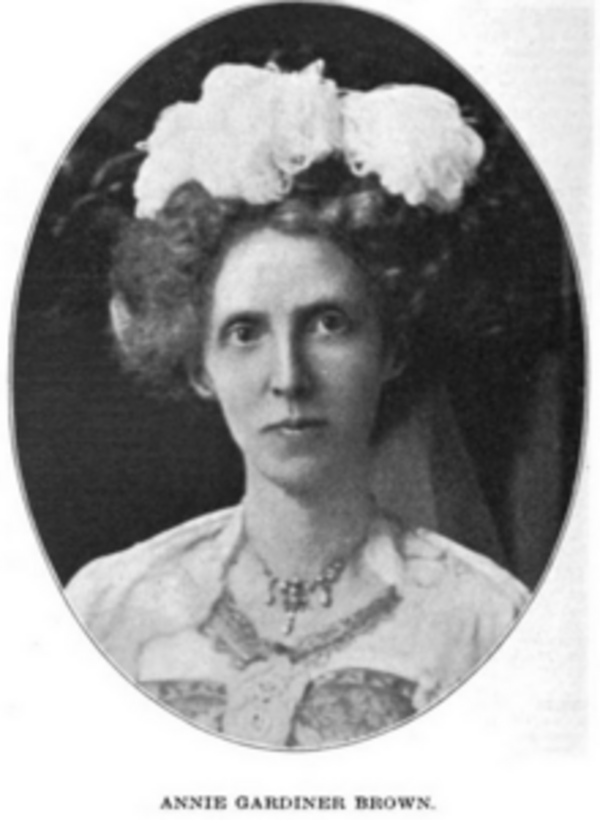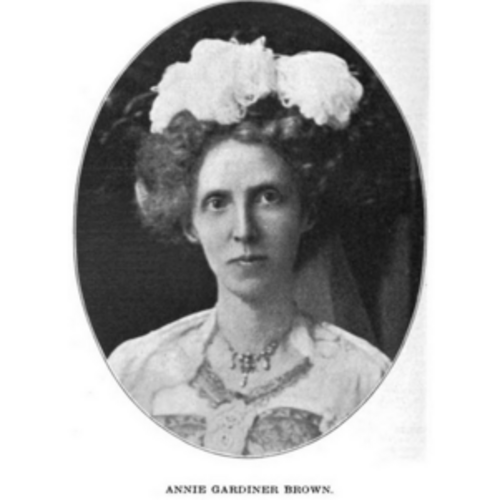
Source: Courtesy of Wikimedia Commons
BARR, ANNIE GARDNER (Gardiner) (Brown), artist and social reformer; b. 29 July 1864 in Norwich, Upper Canada, daughter of James Barr and Beatrice Eadie; m. 10 Oct. 1895 George William Brown (d. 17 Feb. 1919) in Norwich, Ont., and they had a daughter and a son; d. 29 June 1921 in Regina.
In the 1871 census Annie G. Barr is listed as the youngest of six children (four sisters and one brother). Her parents were of Scottish heritage, and her father was then clerk of the Division Court in Norwich. Little is known about her childhood. A talented individual, she attended the Brantford Young Ladies’ College. Upon graduation in 1883 she received rewards for excellence. She was also gifted in art and received formal training, including instruction at Alma Ladies’ College in St Thomas. She graduated in 1893, and obtained a special mention for a still-life study exhibited at the Columbian exposition in Chicago that year.
She arrived in Regina on 17 Oct. 1895 as the 31-year-old bride of George W. Brown, and rose to a position of prominence in “the last best west.” Her husband had been born and raised in Holstein, Ont., and had studied at the Brantford Collegiate Institute and the University of Toronto. In 1882 he moved to the North-West Territories, where he and his three brothers homesteaded. Several years later he settled in the territorial capital of Regina and studied law; he was called to the bar in 1892. His law firm prospered, his business interests expanded, and politics beckoned. Brown, a Liberal, served in the legislature from 1894 to 1905, and later was briefly a Regina alderman. His local interests included education. He served for over a decade on the public school board and would play a major role in establishing the Methodist-affiliated Regina College in 1910–11.
On 14 Oct. 1910 George W. Brown was sworn in as lieutenant governor of Saskatchewan, succeeding Amédée-Emmanuel Forget. Until his retirement in 1915 his wife was his complement in this role. Press clippings describe her as “quiet and unassuming,” “extremely popular,” “exceedingly gracious and highly endowed intellectually and artistically.” Also noted were her devotion to home, her social role, and her work in numerous women’s organizations. As the chatelaine of Government House, she stepped into a position for which she had, in effect, been groomed, and a diary that she kept during these years illustrates in usually terse, descriptive fashion her many interests and talents. (She also kept a scrapbook but it focused more upon her husband’s official activities.)
Although the mother of two young children – Beatrice Annie, born 8 March 1897, and Gordon Barr, born 15 May 1901 – Annie Brown had quickly become a prominent figure in Regina life. A devout Methodist (she had been a Presbyterian before her marriage), she attended Metropolitan Church and was active in its Ladies’ Aid. It was this affiliation that apparently led to her initial involvement with the Local Council of Women, an umbrella group for most women’s organizations, and one she served in an executive capacity.
Among the many organizations in which she was a member (and sometimes an office holder) were the Woman’s Christian Temperance Union, the Young Women’s Christian Association, the Imperial Order Daughters of the Empire, the Women’s Musical Club, the Aberdeen Association, and the Hospital Aid. In 1913 she became active in the newly formed Women’s Educational Club, an auxiliary for Regina College with a particular focus on the promotion of art, for her a lifelong pursuit. The organization most often mentioned in her diary, however, was the Kannata Club, a small group of Regina women of cultural and intellectual bent – with some interest in women’s rights issues. Although she was not a major suffragist in Saskatchewan (which was to become the second province to grant the vote to women, in 1916), Annie Brown attended at least one local suffrage meeting, and she is listed as honorary president on the letterhead of the Provincial Equal Franchise Board of Saskatchewan, formed in 1915. Like so many “organization women,” she did extensive war work during the Great War and participated in Red Cross activities. In fact, her obituary in the Regina Morning Leader states that in 1920 she received recognition from the Serbian king, government, and Red Cross for her work as president of the Saskatchewan Serbian Relief Committee.
At the time of her death she had been a widow for more than two years.
AO, RG 80-5-0-227, no.9216. LAC, RG 31, C1, 1871, South Oxford County, Ont., North Norwich, div.3: 36. Saskatchewan Arch. Board (Saskatoon), S-1.20 (Annie G. Brown fonds) (mfm.). Morning Leader (Regina), 30 June 1921. N. F. Black, History of Saskatchewan and the North-West Territories (2v., Regina, 1913), 1: 307. Who’s who and why, 1914. Who’s who in western Canada . . . (Vancouver), 1912.
Cite This Article
Ann Leger-Anderson, “BARR, ANNIE GARDNER (Gardiner) (Brown),” in Dictionary of Canadian Biography, vol. 15, University of Toronto/Université Laval, 2003–, accessed December 12, 2025, https://www.biographi.ca/en/bio/barr_annie_gardner_15E.html.
The citation above shows the format for footnotes and endnotes according to the Chicago manual of style (16th edition). Information to be used in other citation formats:
| Permalink: | https://www.biographi.ca/en/bio/barr_annie_gardner_15E.html |
| Author of Article: | Ann Leger-Anderson |
| Title of Article: | BARR, ANNIE GARDNER (Gardiner) (Brown) |
| Publication Name: | Dictionary of Canadian Biography, vol. 15 |
| Publisher: | University of Toronto/Université Laval |
| Year of publication: | 2005 |
| Year of revision: | 2005 |
| Access Date: | December 12, 2025 |



